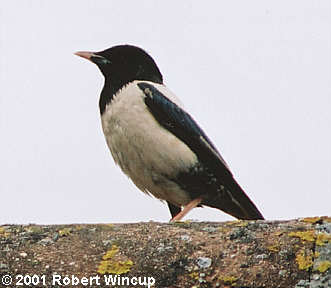|
|
ROSE-COLOURED STARLING
Sturnus roseus
Carlton Colville
2001
by Robert Wilton

WHO WOULD
OF THOUGHT one of the years avian highlights would turn up in suburban Carlton
Colville? Not me! On the morning of July 30 at about 9:00am Dick Walden
received a phone call from Mr. Terry Tarbox who described a bird he had
seen on the roof of his house in Carlton Colville. Using a field guide he
had tentatively identified the bird as a Rose-coloured Starling. From the
description he had given, Dick was convinced that the identification was
correct, however he was at work at the time and was therefore unable to
go down himself. The news was therefore phoned out to Birdline East Anglia
and Carl Buttle who went straight away and confirmed the I.D.
The starling
was widely twitched in the afternoon as it spent most of its time on the
roof tops of Tudor Walk. Its striking plumage made it fairly easy to pick
out amongst small groups of starlings either perched or flying over. However,
it wasn't seen after 4:00pm much to the frustration of those who had been
at work. Its stay
was shorter than many hoped for, but sweet for those fortunate enough to
catch up with it. During its two day stay it often went missing for long
periods. Combined with the fact it wasn't seen either early in the mornings
or in the evenings several Lounge Lizards managed to dip out.
 The
individual at Carlton Colville was a first summer bird, the brownish retained
juvenile lesser secondary coverts and some retained secondaries are clearly
visible in the photo to the left. When the wings were spread it could be
seen that there were five or six brown secondary feathers in the left wing.
The remainder of the plumage is very similar to an adult, with the black
feathering strongly glossed blue. The fairly bright clear pink body plumage
indicates that it is a male, the quite prominent crest and uniformly dark
nape are indicative of this as well. Females of all ages have rather duller
pinky brown body plumage, with shorter crests and a dusky brownish nape.
The
individual at Carlton Colville was a first summer bird, the brownish retained
juvenile lesser secondary coverts and some retained secondaries are clearly
visible in the photo to the left. When the wings were spread it could be
seen that there were five or six brown secondary feathers in the left wing.
The remainder of the plumage is very similar to an adult, with the black
feathering strongly glossed blue. The fairly bright clear pink body plumage
indicates that it is a male, the quite prominent crest and uniformly dark
nape are indicative of this as well. Females of all ages have rather duller
pinky brown body plumage, with shorter crests and a dusky brownish nape.
There have
been two other records of Rose-coloured Starling in Lowestoft. The first
was an adult back in 1960. Seen on several dates between May 13-20th it
was generally considered at the time to be an escape due to 'its tameness
and worn plumage'. Nowadays it may not have been given such a hard time.
The second occured thirty five years later, between June 17-27th 1995 and
did not suffer from the cagebird theory.
After spending
the winter in the Indian Subcontinent Rose-coloured Starlings migrate north
to the Steppes of Central Asia spreading westwards to Turkey and the Ukraine.
Its actual breeding range each year is dependent upon its food supply, swarms
of grasshoppers and locusts, and as a result it regularly irrupts westwards
into countries such as Hungary and Italy. Once the breeding grounds are
reached nesting is triggered by the abundance of grasshoppers and locusts
which are preyed upon during a seven week flightless stage these insects
pass through. Breeding occurs almost immediately after an insect plague
is discovered.
In a recent
press release by the British Birds Rarities Committee it was announced that
along with Black-crowned Night Heron Nycticorax nycticorax and American
Wigeon Anas americana, Rose-coloured Starlings will loose their status
as national rarities as of January 1, 2002. The decision is a result of
two bumper years. In 1999 there were 22 records with around 45 in 2000,
double that of the previous year. It is unclear at the moment how many have
been recorded this year but a similar figure wouldn't be a surprise. Whatever
their status Rose-coloured Starlings will continue to cause one or two armchairs
to be deserted in the future!!!
Thanks to
Dick Walden and Andrew Easton for their help preparing this article (and
to Mr. Terry Tarbox for phoning Dick).
References:
Payn, W. H. The Birds of Suffolk. 1978. Ancient House Publishing.
Walton P. & Millington R. The Birding Review of 2000,
Birding World: Volume 13 Number 12.
|
|